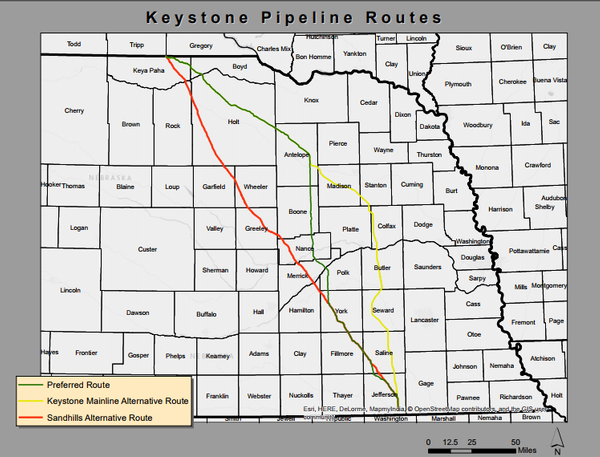TUESDAY, NOVEMBER 21, 2017
Nebraska’s Public Service Commission approved an alternate routing for TransCanada’s long-disputed Keystone XL project, opening the door for construction to begin, though questions still surround the 1,179-mile planned oil pipeline.
Approval by Nebraska regulators was the final major bureaucratic hurdle for the project, which was first proposed in 2008.

 |
| Nebraska Public Service Commission |
|
The Nebraska Public Service Commission has approved the Keystone XL Pipeline's Mainline Alternative Route, shown here in yellow. |
Keystone XL, which would carry crude oil from the oil sands of Alberta to Steele City, Nebraska, was first proposed in 2008 and went through years of environmental reviews and regulatory holdups before the U.S. State Department rejected the pipeline in November 2015. The project was thought to be dead in the water at that point, though procurement of some of the materials had already begun.
President Donald J. Trump invited the company to resubmit its application for federal permission when he took office in January, and the government overturned the previous rejection in March.
Alternative Route
The PSC voted 3-2 to approve the pipeline contingent on TransCanada using the so-called Mainline Alternative Route, rather than its preferred route. The Mainline Alternative co-locates with established rights-of-way, including the existing Keystone Pipeline, over more miles than the preferred route, which, the commission says, was originally established simply because it was the shortest possible route between Hardisty, Alberta, and Steele City.
 |
| © TransCanada Corporation. All rights reserved. |
|
Keystone XL, should TransCanada decide to go through with the project, will stretch from Hardisty, Alberta, to Steel City, Nebraska. |
The Mainline Alternative, being co-located with the existing pipeline, will make emergency response quicker and easier, the PSC said in its decision, and would maximize monitoring resources. The alternative route also minimizes the environmental impact of the project.
Commercial Viability
While the Nebraska approval means the project can go ahead legally now, the Canadian energy company said in August that it was also assessing the commercial viability of the project at this point. It is expected to make a final decision on the project by next month.
Whether TransCanada moves forward with the plan could depend on demand in the U.S. in comparison with other destinations, especially Asia.
According to the Canadian Association of Petroleum Producers, while the U.S. is currently the destination of 99 percent of Canadian oil exports, China and India are poised to constitute 90 percent of the world’s increased demand over the next 25 years. The organization notes that U.S. oil production has been growing in the past decade, making the United States Canada’s “biggest customer and its biggest competitor.”
The International Energy Agency reported last week that the U.S. continues to take the lead in petroleum production, and predicted that, in the next decade or so, the country would become a net exporter of oil. China, meanwhile, is the world’s largest consumer of oil.
Flagging oil prices in general could also play into the company’s decision on the future of the project. Prices for Western Canadian Select crude oil have held in the $30- to $40-per-barrel-range in the past year, compared with prices between 2010 and 2014, when the oil generally sold at $60 to $85 per barrel.
Keystone Pipeline Spill
The approval comes as TransCanada works to clean up a spill of an estimated 5,000 barrels of oil on its Keystone Pipeline in Amherst, South Dakota. The company has not determined the cause of the spill, which was detected early Thursday (Nov. 16), but says there has been “no significant environmental impact observed or threat to public safety.”
A representative of the South Dakota Department of Environment and Natural Resources told Reuters that the last Keystone spill, in April 2016, involved about 400 barrels, and took 10 months to clean up. The state expects cleanup of this release to take longer, at least a year.
Tagged categories: Government; Infrastructure; Oil and Gas; Pipelines; Program/Project Management